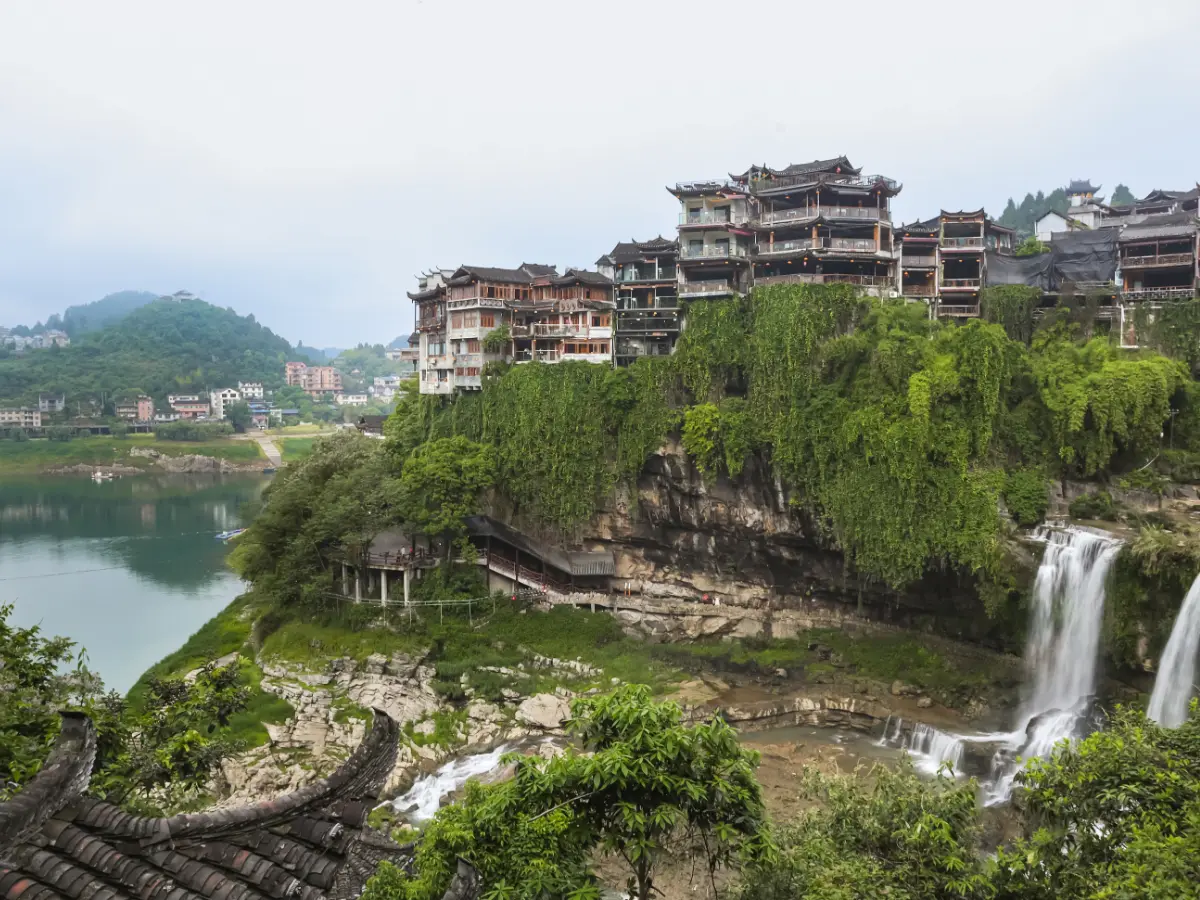Looking for what to do in Furong Ancient Town? Then you’re in the right place.
This peaceful cliffside village totally surprised me (in the best way possible).
I first came across Furong Ancient Town (also known as Furongzhen) on social media. A video showed it glowing at night, with lanterns lighting up the waterfall, and I instantly saved it. Months later, I actually spent my birthday morning in Furong, and honestly? I couldn’t have picked a better place to wake up to.
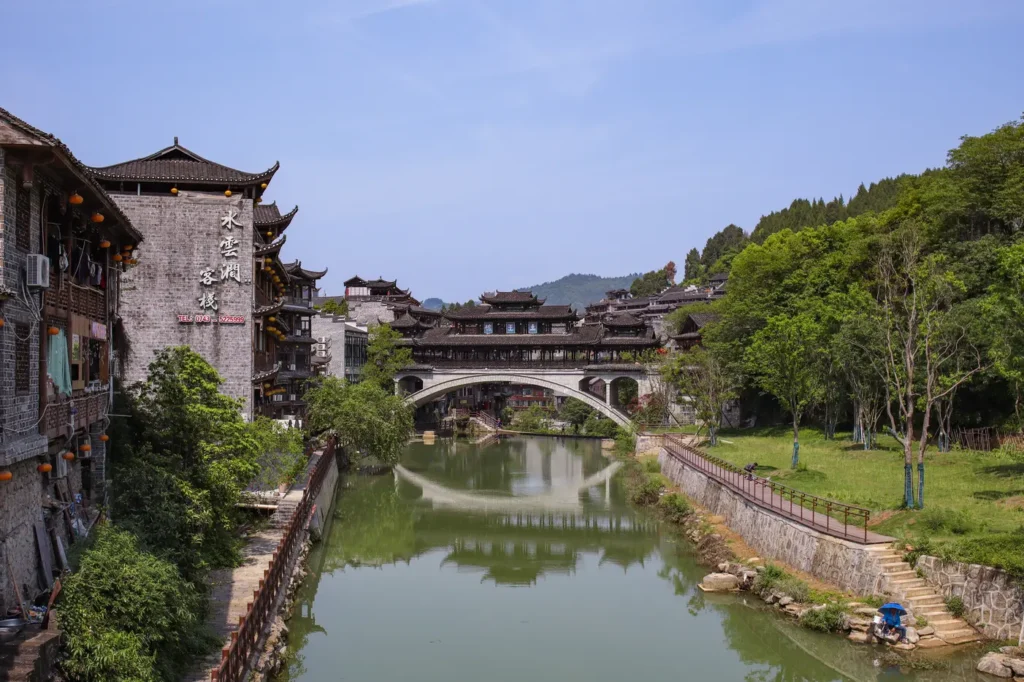
Located in Hunan province, Furong village is an old Chinese town and everything you’d want in an off-the-radar destination.
Think cobblestone streets, wooden stilt houses, and a 60-meter waterfall crashing right through the middle of town. It’s home to the Tujia ethnic minority, known for their distinct wooden architecture, bold red-and-black embroidery, and ancient customs passed down for generations.
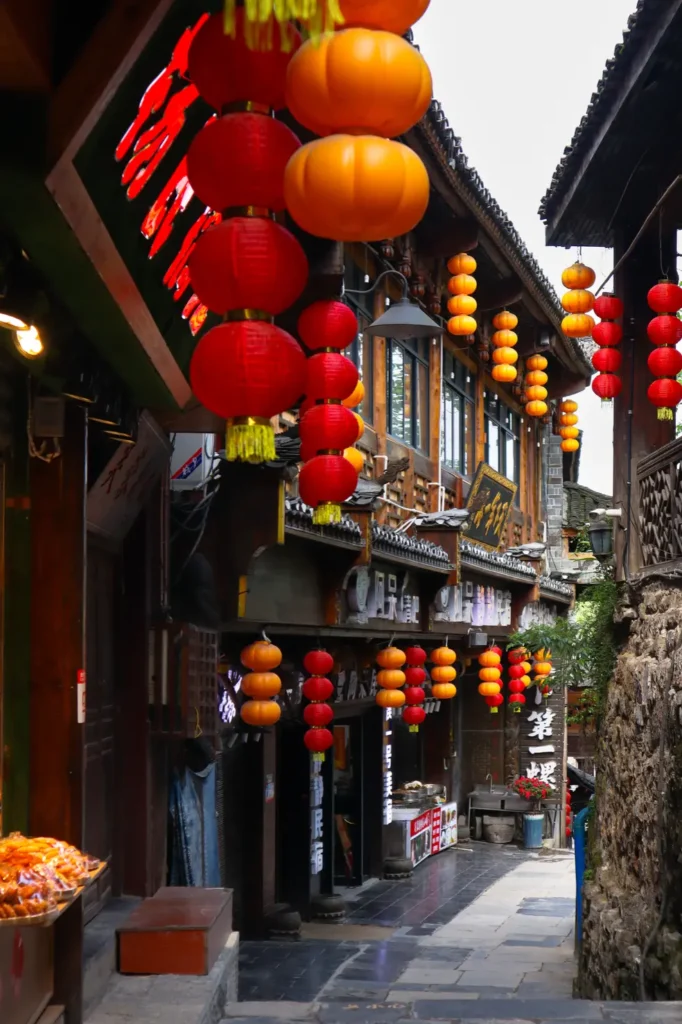
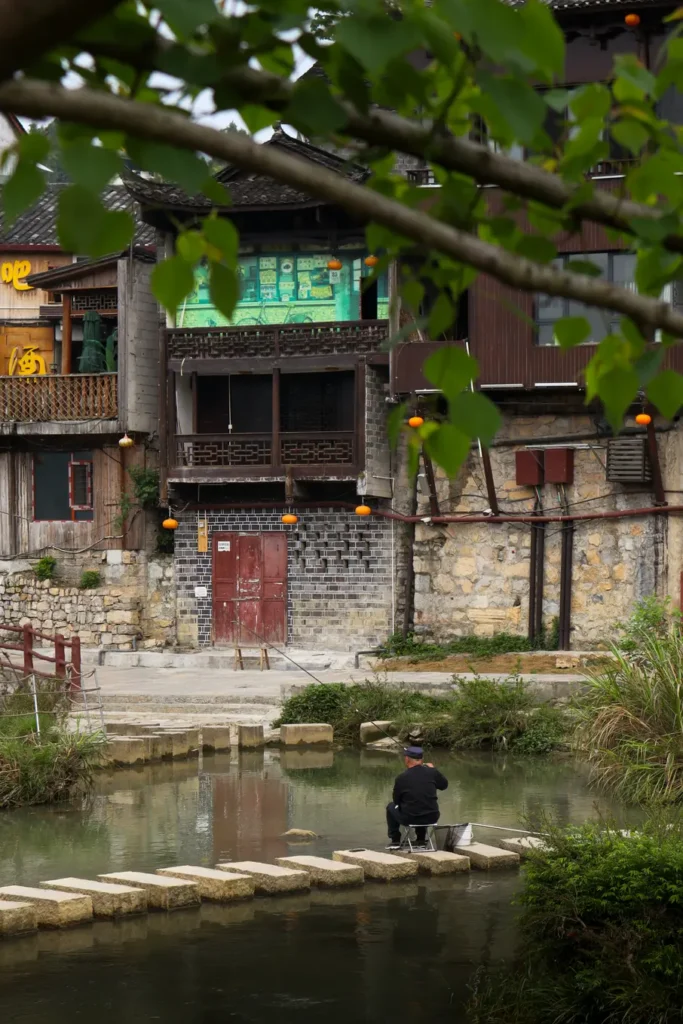
This post will walk you through exactly how to plan your visit. You’ll learn how to get there, the best things to do in Furong Ancient Town, when to go, where to stay, and more.
Oh, and if you’re visiting Zhangjiajie National Park or Tianmen Mountain, you’re in luck—Furong makes for the perfect side trip from either.
In a hurry? Plan your visit to Furong now!
📍Top sights: Waterfall | Old Streets | Tusi Palace
⌛ How long to spend in Furong: Half a day to one day (but try to spend one night there)
🚆How to get to Furong – Traveling by train is one of the most efficient ways to get around China. You can book tickets on the official 12306 app, but I personally recommend using Trip.com since it’s way more user-friendly.
🎟️ Price: 108 RMB (~13€). You need to pay an entrance fee to visit the scenic area.
😴 Where to stay: Tuwang Palace Waterfall Inn
💸 How to pay in China – It’s a cashless society. You’ll need Alipay or WeChat Pay to make purchases — literally everywhere. Use Revolut to pay in yuan and avoid foreign transaction fees.
💊 Best travel insurance for China – I recommend Heymondo for its excellent balance between affordability and quality.
🛜 Best way to stay connected in China – If your phone supports eSIM, use Airalo (MARIAN4315 = 3$ off). Otherwise, get a China Unicom or China Telecom SIM. Don’t forget a VPN to access apps like WhatsApp and Instagram.
Where to stay in Furong
If you’re visiting Furong Ancient Town, do yourself a favor and stay overnight—preferably somewhere with a balcony that overlooks the waterfall.
Trust me, waking up to the sound of water crashing down the cliffs is next-level peaceful. It honestly felt like nature’s version of a white noise machine.
There are plenty of guesthouses and small hotels scattered around the village. Some are more modern, while others are traditional wooden homes converted into inns.
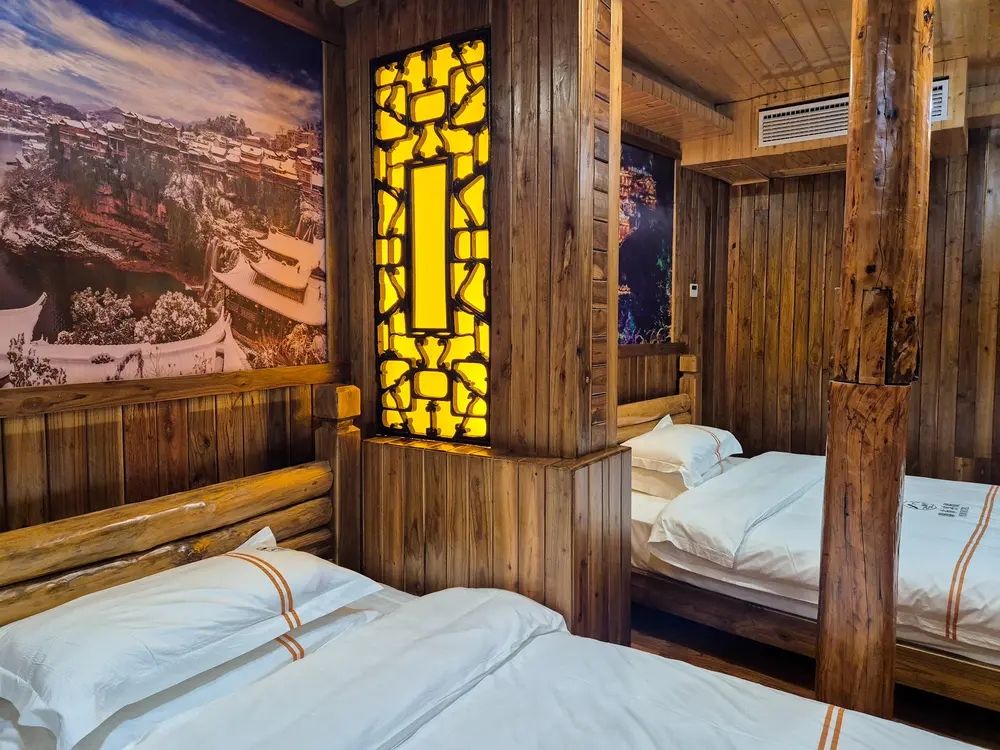
I stayed at Tuwang Palace Waterfall Inn, and it was worth every euro. It wasn’t the cheapest place in Furong village, but hey—it was my birthday, and I decided to treat myself.
The room had a huge window and a balcony that looked straight out at the waterfall. I even sat on the balcony to have breakfast, just watching the town slowly wake up.
If you’re on a tighter budget, the inn also has cheaper rooms, but those don’t come with a waterfall view.
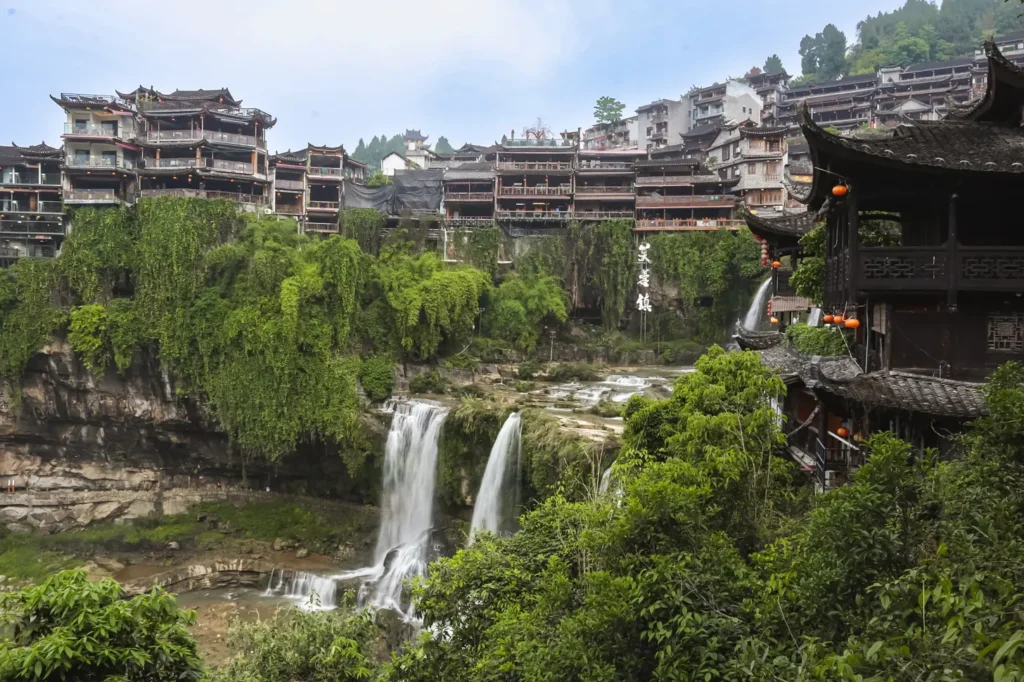
Anyway, here are a few more accommodation options in Furong:
Tip: These places can fill up fast, especially on weekends and holidays. I’d recommend booking at least a few days ahead, especially if you’re combining your trip with Phoenix Ancient City or coming from Zhangjiajie.
💼 TRAVEL INSURANCE: Unexpected events happen anywhere in the world, so I always recommend getting travel insurance. I regularly use Heymondo, which offers some of the highest coverages on the market at very competitive prices. As well as covering medical expenses, Heymondo’s insurance also covers the loss or theft of luggage, electronic equipment and more. They also have a 24/7 customer service through their App. As A Ticket to Take Off reader, you get a 5% discount when purchasing Heymondo insurance. The purchase must be made using this link, and the price shown on the website already includes the discount.
What to do in Furong Ancient Town
You can see the main highlights—like the waterfall, Wuli Slate Street, and Tusi Palace—in just 2 to 3 hours if you’re short on time.
But here’s the thing: spending a night in Furong is 100% worth it. The town takes on a completely different vibe after dark. Picture glowing lanterns, quiet streets, and the sound of the waterfall in the background.
» Walk through the Old Streets of Furong
If you’re not sure where to start, just walk. Seriously, one of the best things to do in Furong Ancient Town is to wander aimlessly through its narrow stone paths.
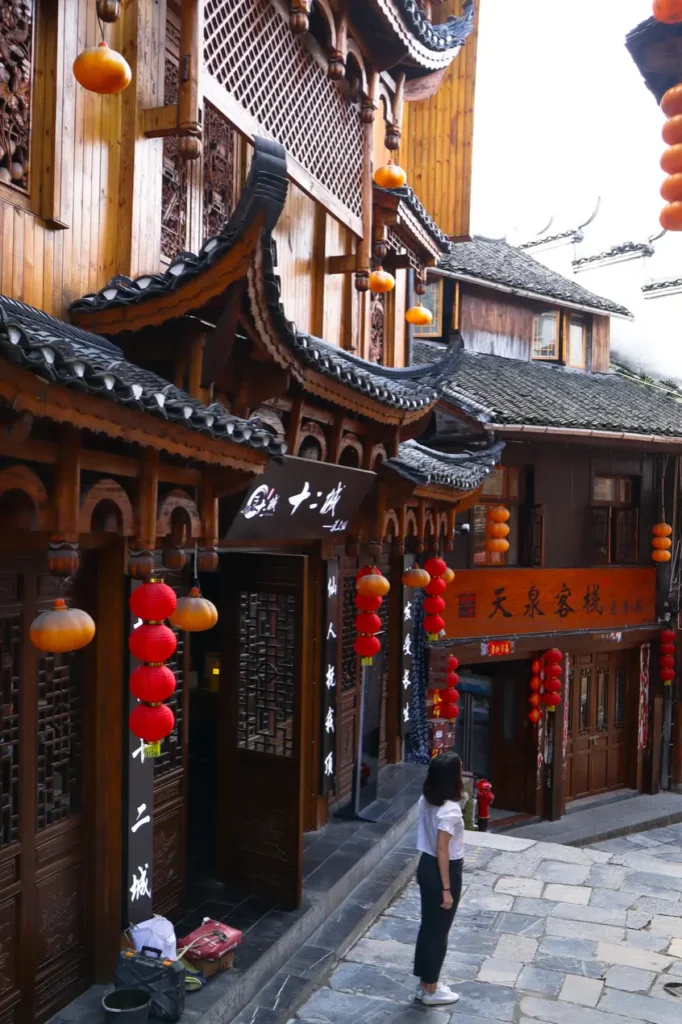
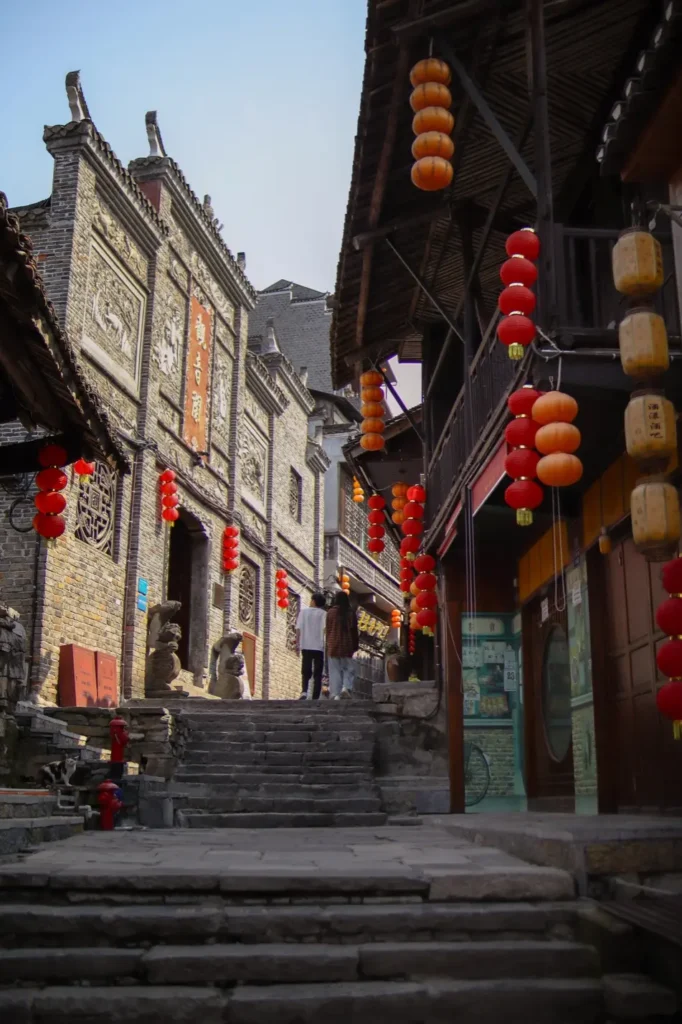
Start at Wuli Slate Street, the town’s main historic road. The houses lining the street still carry the look of old Tujia architecture.
Along the way, you’ll get to see locally-run teahouses, souvenir shops, and open balconies with locals hanging out.
» Walk across Tuwang Bridge
Make sure to also stop by Tuwang Bridge, one of the best photo spots in Furong. This covered bridge crosses the river and gives you a panoramic view of the stilted wooden houses stacked along the cliffs on both sides.
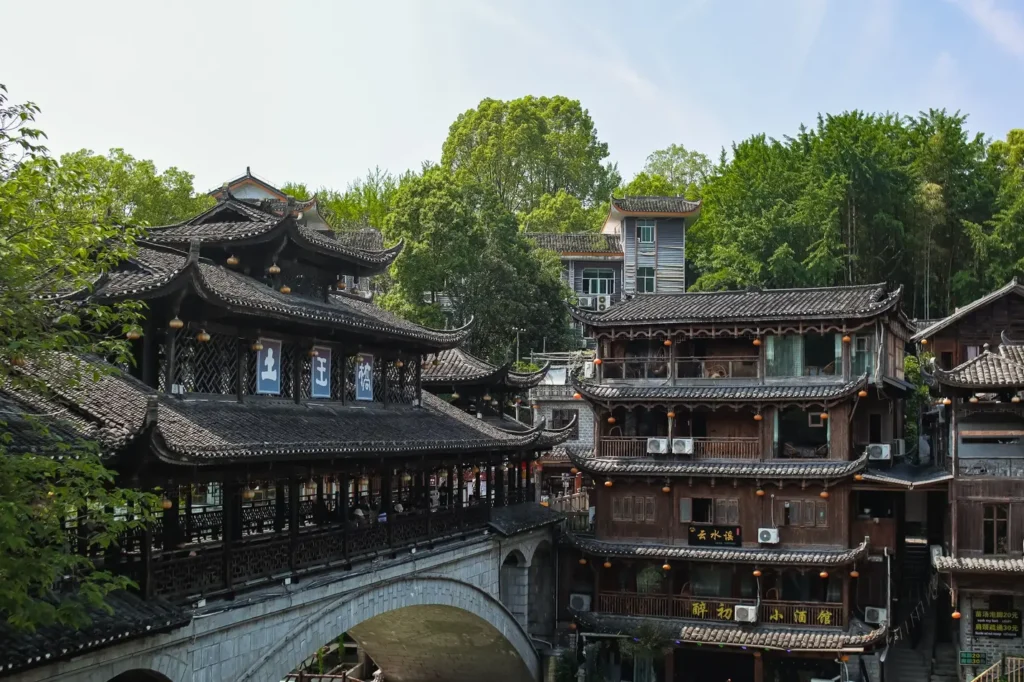
It’s especially scenic in the early morning or late afternoon, when the light hits the buildings just right. Even if you’re not into photography, the views from here are hard to beat.
» Visit the Furong Waterfall
This is the postcard shot of Furong—and it’s even more breathtaking in person. The 60-meter waterfall cuts right through the village, crashing down into the river below.
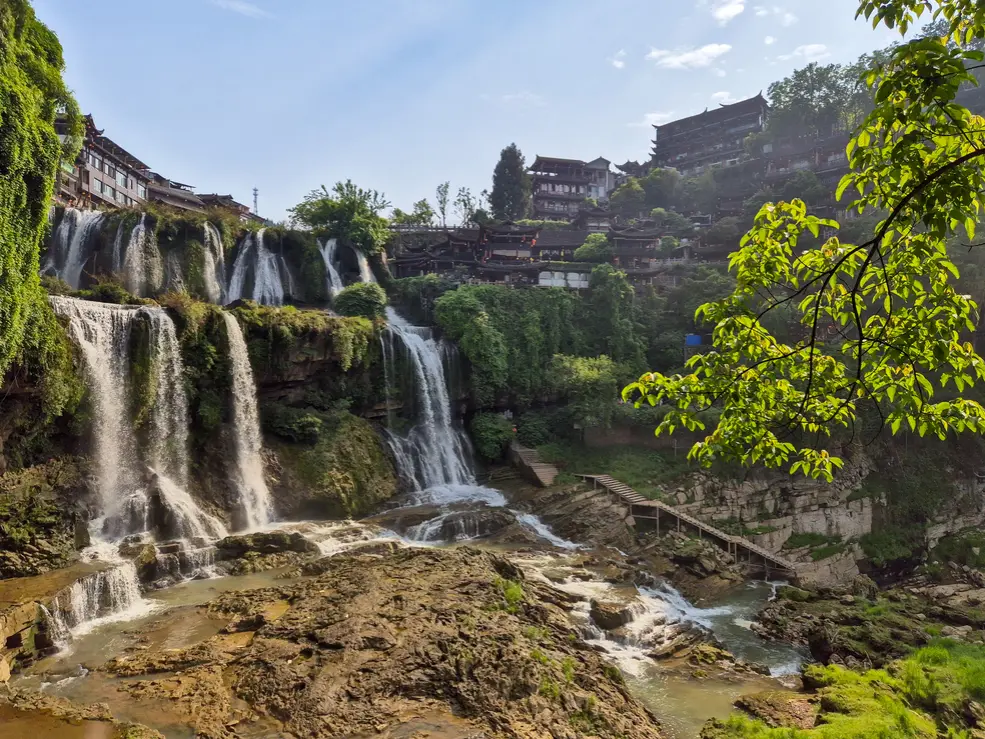
To really take it in:
- Head to the lower viewing platform early in the morning. I went at 9 am, and there were barely any people around.
- Walk behind the waterfall. It’s damp and a bit slippery, so wear proper shoes—but the view from behind the water curtain is worth it.
💡 EXTRA TIP: The falls are strongest during and after the rainy season (June–August). If you’re visiting then, expect a serious water show.
» Explore Tusi Palace/Youyang Palace
Perched right above the waterfall, the Tusi Palace was once the summer retreat of a Tujia king—and it still feels majestic today. The wooden buildings, decorated with carved details and red lanterns, offer some of the best panoramic views in town.
If you’re only going to visit one historical site in Furong, this is the one to prioritise.
» Experience Tujia Culture and Traditions
Furong isn’t just a pretty village with waterfalls—it’s a living piece of Tujia heritage. You’ll find signs of this culture everywhere.
One of the most striking features is the traditional stilt houses, built right into the cliffs. These wooden homes are elevated on tall beams, designed to adapt to the mountainous landscape. You’ll see them all around the town, especially near the riverfront, blending beautifully with the natural surroundings.
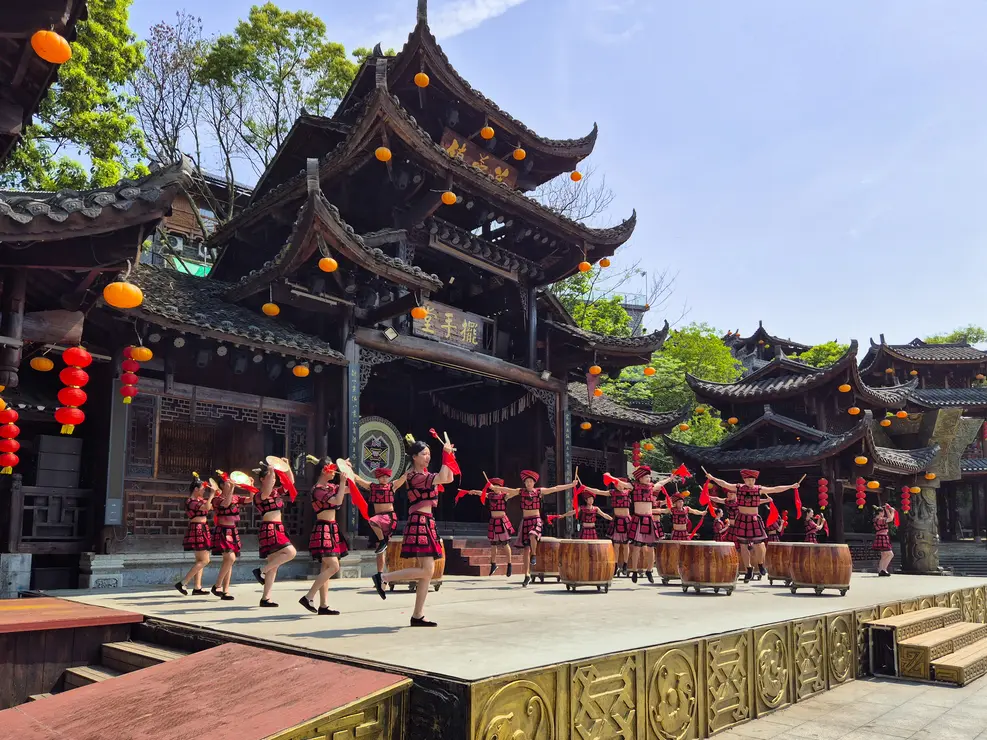
During the day, explore a small Tujia folk museum if you want to learn more about this culture. While I didn’t visit the museum myself, there you can find objects and artefacts that showcase the Tujia culture.
In the evening, don’t miss the live performances—they’re included in your village ticket and happen every night.
I also saw several photographers offering photoshoots in Tujia and Miao-style outfits. It’s definitely a bit touristy, but if you’re in the mood for something fun and local, it’s worth considering.
» Enjoy the night view over the waterfall
If you’re staying the night (which I totally recommend), don’t skip a nighttime walk. After sunset, Furong transforms. The waterfall is lit with warm golden lights, lanterns glow softly along the streets, and the air feels cooler and calmer.
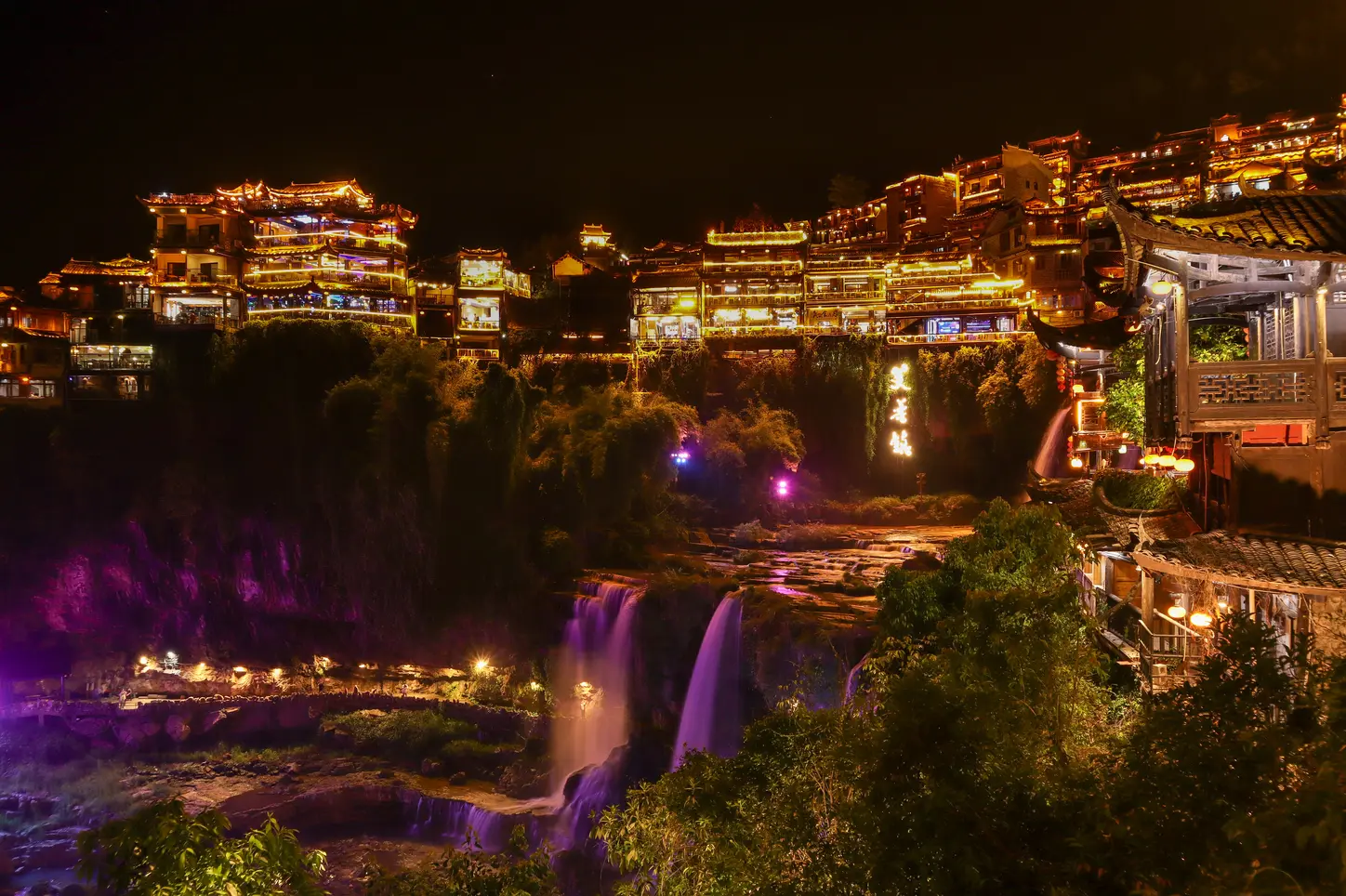
Bring a tripod or use your night mode. Some of the best photos I took in Furong were at night. Honestly, it was one of those moments where I just stood there thinking, How is this place not more famous?
How to get to Furong Ancient Town
Furong might feel remote, but it’s actually pretty easy to reach, especially if you’re already exploring Zhangjiajie, Fenghuang Ancient Town, or Changsha.
I came across a few outdated posts saying there’s no train station in Furong—but that’s no longer true. Since December 2021, Furongzhen Station has been up and running, making it much easier to reach the old town by train.
You can get there by train, bus, or even by Didi (China’s version of Uber). However, please be aware that Didi doesn’t operate in Furong.
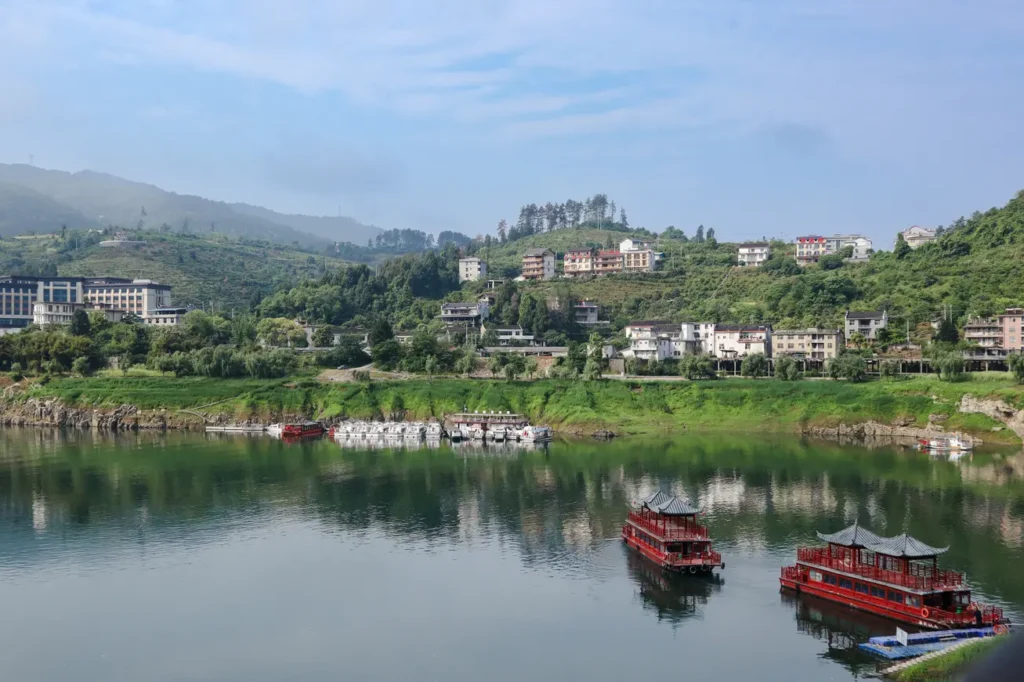
From Zhangjiajie to Furong Ancient Town
This is the most common starting point—and exactly how I got there, right after spending the day at Tianmen Mountain.
- By train: Take a train from Zhangjiajie West Station to Furongzhen (芙蓉镇站). It takes about 25 min and costs around 5€. From the station, it’s a short 10–15 minute drive to the old town.
- By Didi/private car: A direct Didi from Zhangjiajie takes 1h30, depending on traffic.
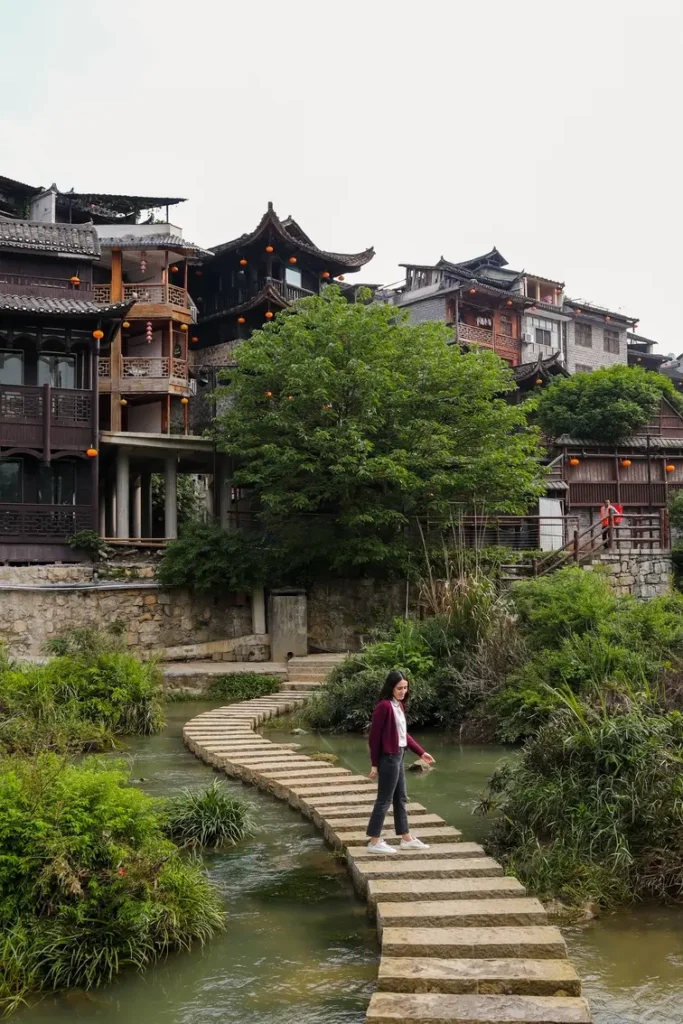
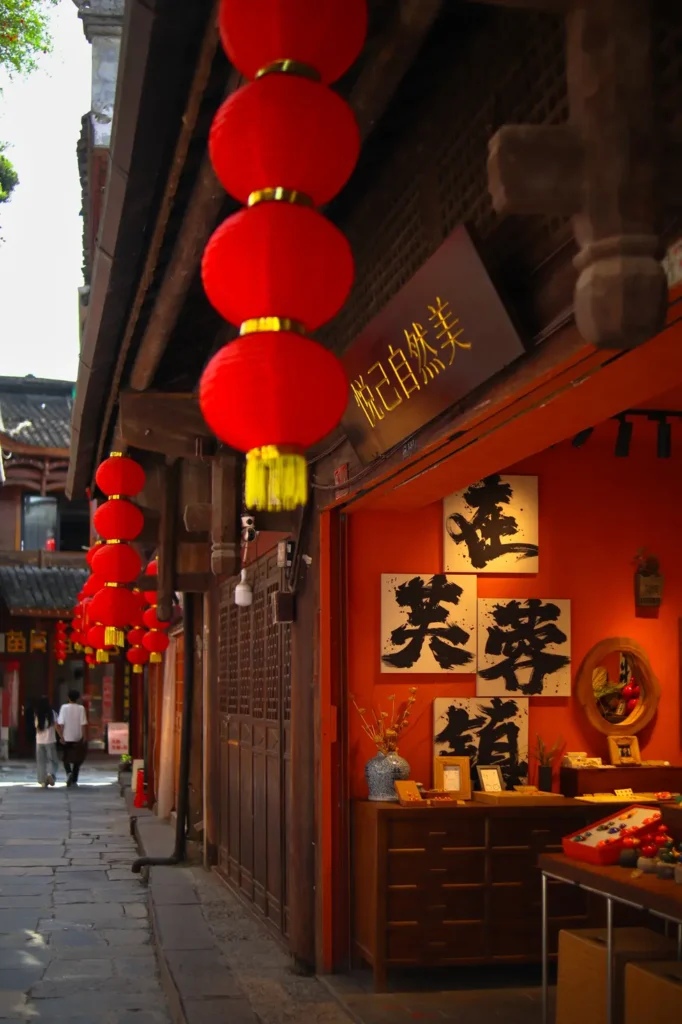
From Fenghuang to Furong Ancient Town
If you’re heading from Phoenix Ancient City, Furong makes a great next stop.
- By train: There are trains connecting Fenghuang Gucheng to Furongzhen. It takes about 40 minutes and costs ~7€.
- By Didi: A direct ride takes about 1h50 and it’s way more expensive. I don’t recommend this option.
💡 EXTRA TIP: Download 12306 China Railway or use Trip.com to check schedules in English and buy your train tickets in advance.
From Changsha to Furong Ancient Town
Changsha is one of the closest big cities to Furong Ancient Town, and one of the easiest starting points if you’re coming from elsewhere in China.
You can take a direct high-speed train from Changsha Train Station to Furong Town Station (芙蓉镇站) without needing to transfer. The ride usually takes just over 3 hours and costs around ~30€ in second class.
Best time to visit Furong
Furong Town is open year-round, but some seasons are definitely better than others, depending on what you’re after.
- Spring (March–May): Lush green landscapes and blooming flowers. Fewer crowds and mild weather make it perfect for walking around.
- Summer (June–August): This is when the waterfall is at its most powerful, especially after heavy rain (rainy season starts in June). But it can get very humid and crowded, especially in July and August.
- Autumn (September–November): The air cools down, the trees turn golden, and the light is perfect for photos.
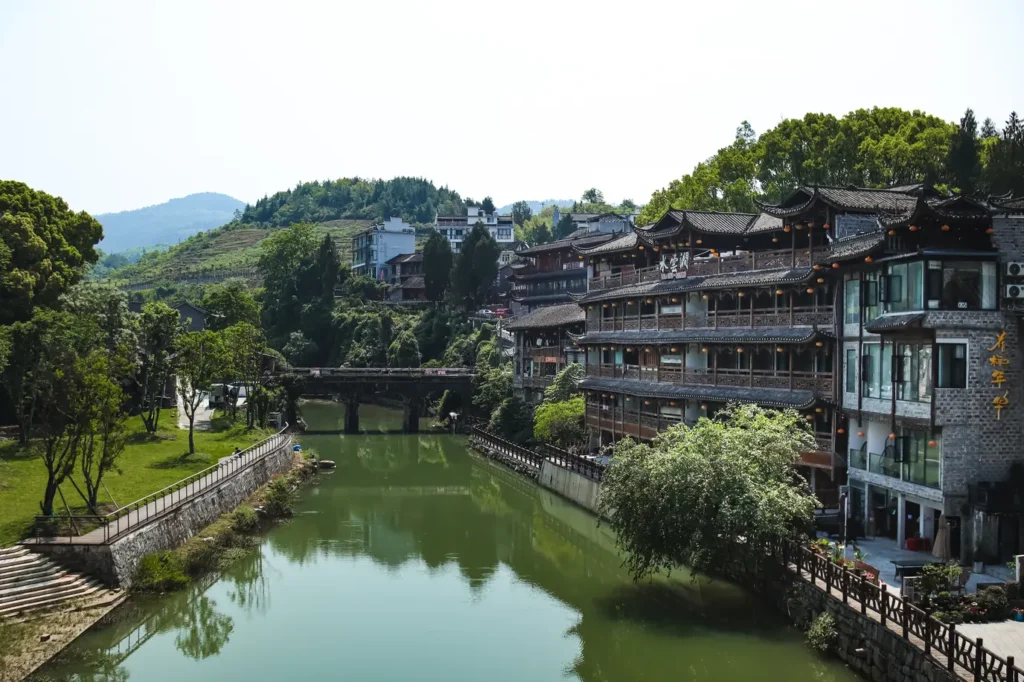
I visited in late April and it was rather hot and sunny. Perfect weather to be honest. I didn’t even need a jacket, just light clothes and good walking shoes.
Please avoid traveling to Furong (and China overall) on major Chinese public holidays like Golden Week (Oct 1–7) and Labor Day (May 1–5). The town gets packed with local tourists and prices can spike.
If you can, plan your visit for a weekday in shoulder season (April, May, or late September). This way, you’ll get the charm of Furong without the crowds.
Other practical travel tips for when you visit Furong
- The entry fee is around 108 RMB (13€) per person. The ticket is valid for 2 days. Once you’ve got your ticket, don’t lose it. There are multiple checkpoints around town where you’ll need to show it.
- While Furong is open all day, some areas close off access at night. For example, the lower part of the waterfall walkway is locked after dark. So, if you want to explore the area behind or beneath the falls, make sure to go before sunset.
- Didi doesn’t work here. We found that out the hard way after arriving at Furongzhen Station and trying to order a ride with no luck. Your best bet is to ask your accommodation to arrange a taxi ahead of time. If not, just find a local driver at the station. We paid 30 RMB (~4€) for the short ride into the old town.
- Make sure you have WeChat Pay or AliPay set up in advance. Most small shops and restaurants don’t take international credit or debit cards.
- Wear proper walking shoes. The town is built on different levels with steep steps and uneven stone paths.
- If you’re visiting in the warmer months, don’t forget insect repellent—mosquitoes love the riverside setting just as much as we do.
- If you’re arriving by train, make sure to search for Furongzhen Station (芙蓉镇站) when booking your tickets. That’s the stop closest to the old town.
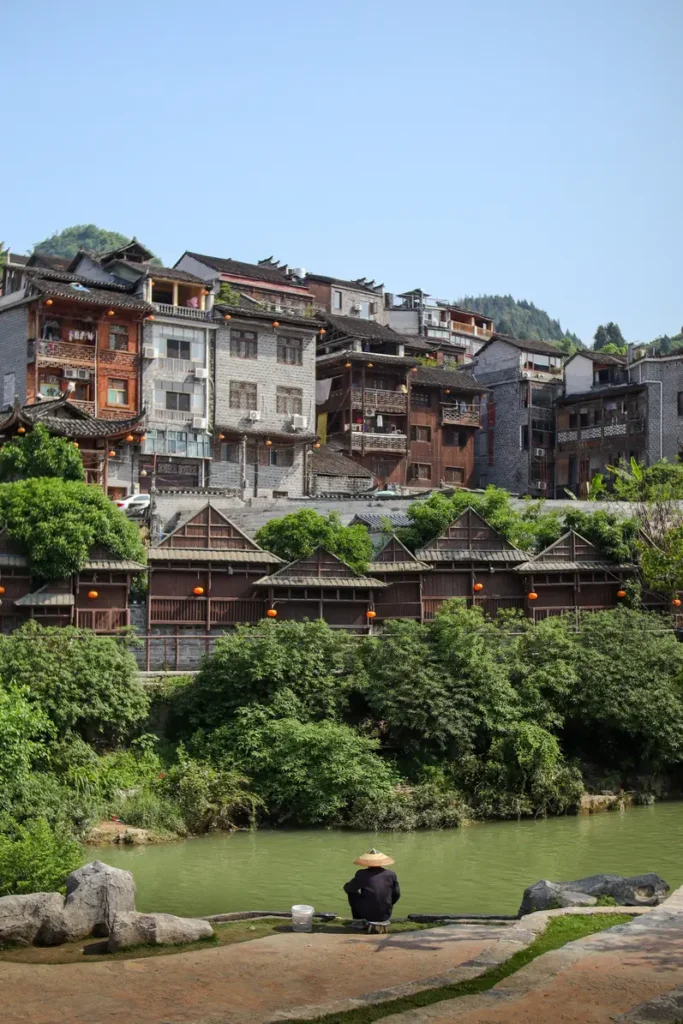
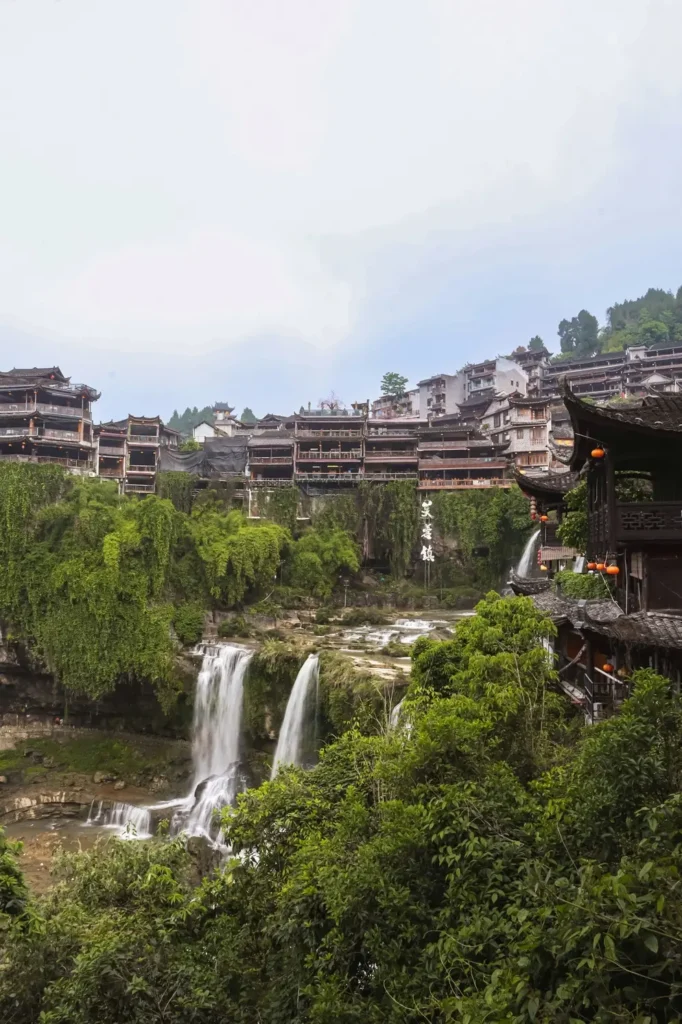
Best places to visit near Furong
Got extra time in the area? You’re in luck—there are some incredible places just a short ride from Furong Ancient Town, perfect for adding to your China itinerary.
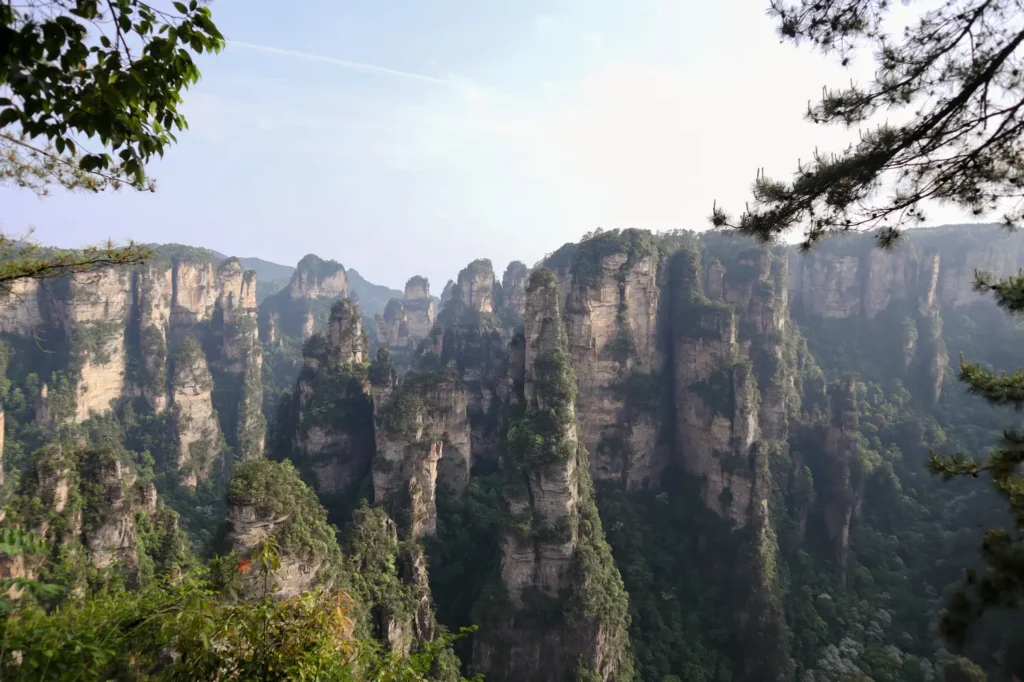
Zhangjiajie National Forest Park
If you’re into dramatic landscapes and jaw-dropping viewpoints, Zhangjiajie National Park is a must. It’s home to the iconic sandstone pillars that inspired Avatar—and yes, it’s even more epic in real life.
Fenghuang Ancient Town
Also known as the Phoenix Ancient City, this riverside town is much more touristy than Furong—but still worth a visit for its night views and preserved architecture.
It’s bigger, busier, and a bit flashier, but has its own kind of magic.
Red Stone Forest National Park
A lesser-known gem just over an hour away, the Red Stone Forest is packed with sharp limestone formations and walking trails.
It’s quiet, scenic, and ideal for a half-day trip if you want to escape the crowds.
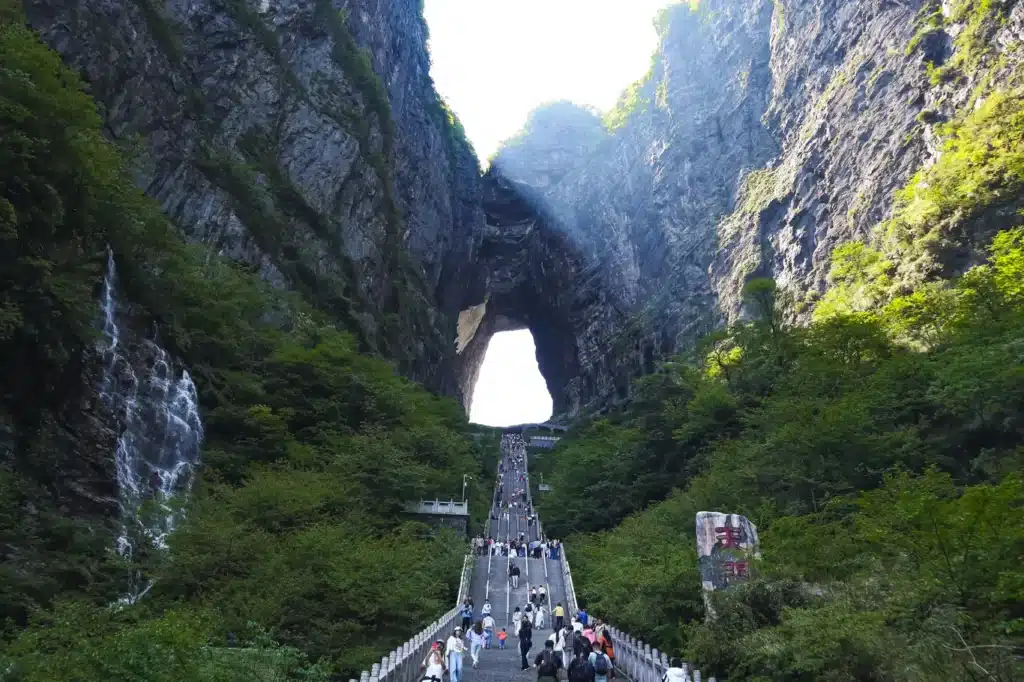
Tianmen Mountain
Tianmen is home to the famous glass skywalk, 999 steps to Heaven’s Gate, and one of the longest cable car rides in the world.
I visited right before heading to Furong and couldn’t believe how close it was.
Frequently Asked Questions about Furong
» Is Furong worth visiting?
Yes—Furong Ancient Town is definitely worth a visit, especially if you’re looking to escape China’s more crowded tourist spots.
It offers a unique mix of natural beauty and culture, with a massive waterfall cutting through the village, preserved Tujia architecture, and peaceful old streets.
Plus, it’s easy to pair with other top destinations like Zhangjiajie or Fenghuang.
» Can you visit Furong on a day trip from Zhangjiajie?
Absolutely. Furong is less than 1 1-hour train ride from Zhangjiajie, making it a doable day trip.
But I recommend staying overnight. The town completely transforms after dark, with lanterns lighting the streets and the waterfall glowing under spotlights. That peaceful nighttime vibe is something you’ll miss if you leave too early.
» How many days do you need in Furong?
You can explore most of Furong Ancient Town in half a day to one full day, especially if you stick to the main sights like the waterfall, Wuli Street, and Tusi Palace.
But to truly enjoy the town’s charm, I suggest spending at least one night there. That way, you get to see the waterfall lit up at night and soak in the relaxed evening atmosphere without the daytime crowds.
» Do people speak English in Furong?
Not really. Like most places in China, English isn’t widely spoken in Furong.
I highly recommend downloading a translator app like Google Translate before you go. It makes a huge difference when ordering food, asking for directions, or checking into your accommodation.
Final thoughts about Furong
If you’re still wondering what to do in Furong Ancient Town, I hope this guide has shown you just how much there is to explore in this peaceful cliffside village.
From the powerful waterfalls to the stilted Tujia homes and the glowing lanterns after dark, Furong Ancient Town is the kind of place that stays with you long after you’ve left.
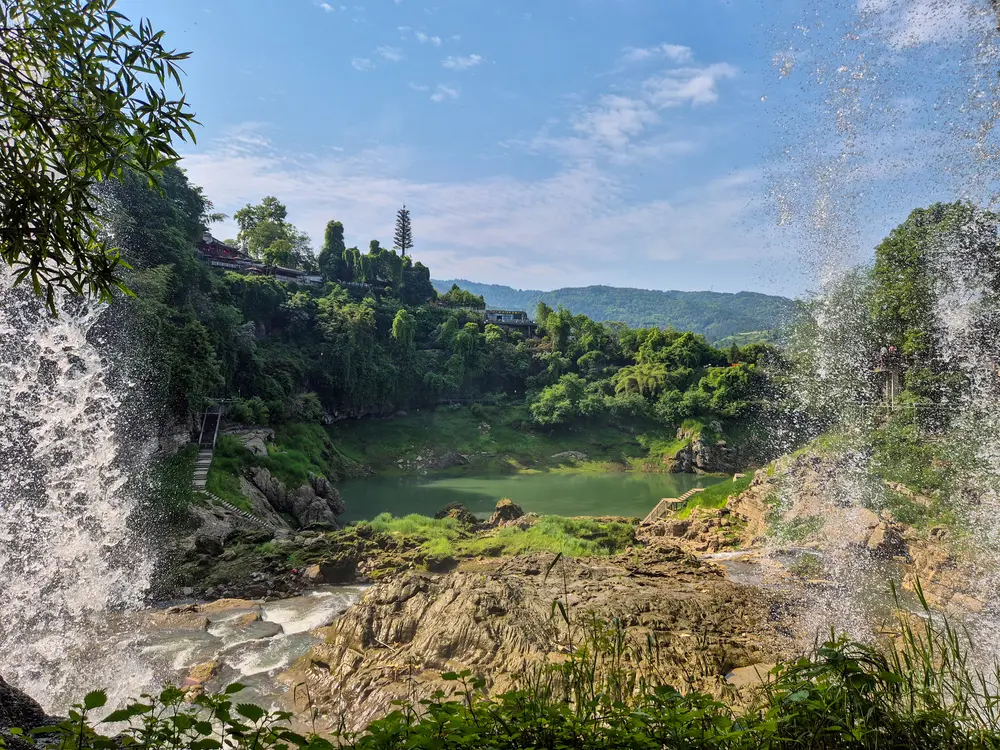
It’s not as famous as other spots in China, but maybe that’s exactly why it feels so special.
If you’ve been to Furong already or you’re planning to go soon, I’d love to hear from you! What are you most excited to see? Or do you have a tip I should add to the post?
Disclaimer: this post may contain some affiliate links, which means I get a small commission if you buy something through my links. This doesn’t represent any additional cost to you and you’ll be supporting my work here on the blog😊

